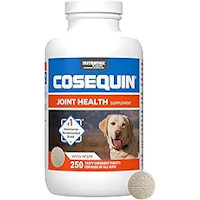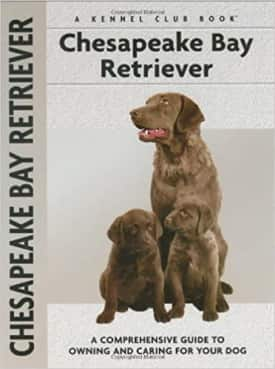Chesapeake Bay Retriever: Complete Breed Guide
The Chesapeake Bay Retriever, primarily bred for duck hunting, takes its name from the bay located off the Virginia and Maryland coastline and from which its ancestors were rescued.
The story goes that two Newfoundland dogs, aboard an
English ship which wrecked in the bay, were rescued along with the crew members and brought to shore.
Subsequently, the
Newfies were interbred with other dogs in the area - most likely coonhounds and curly coated retrievers, which began the
development of the all American Chesapeake Bay Retriever that we know today.
The Chessie, as he is affectionately called, has swimming skills second to none plus all the physical attributes and stamina of a dog bred for working in water and in adverse weather conditions. His body is
muscular, well-developed and protected by a dense oily coat that is weatherproof. He has been known to retrieve up to 300 ducks in a day.
Early on in his development during the 1800s, he was also known as a Red Chester or Brown Winchester. One celebrity owner of the breed was President Roosevelt.
Chesapeake Bay Retriever
BREED AT A GLANCE
ORIGIN: United States - All American, bred as water retrievers
SIZE: Male 65 to 80 pounds, female 55 to 70 pounds
COAT: Dense, short, oily, and wavy double coat
COLOR: Shades of brown, sedge (reddish yellow, red or chestnut), deadgrass (tan/straw)
LIFESPAN: 10 to 13 years
TEMPERAMENT: Affectionate, loyal, energetic, protective
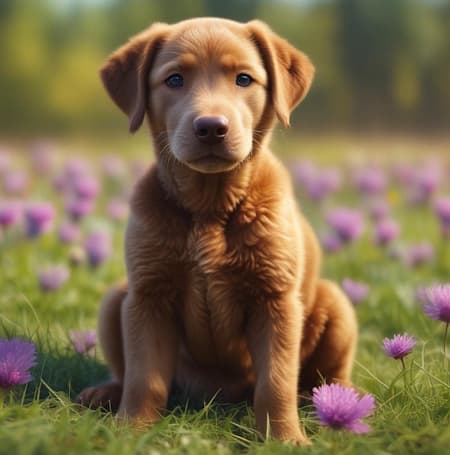
Living With A Chesapeake Bay Retriever
The Chesapeake Bay Retriever has a good disposition and is very affectionate and loyal to its family. All in all a very easy dog to live with according to those who have one. That said, training, from an early age, is a must. The Chessie is a powerful and smart dog with an independent streak and can be uncooperative.
He has a
protective nature about everything he values and while not unfriendly to strangers, his intelligence causes him to take a
more wait-and-see stance.
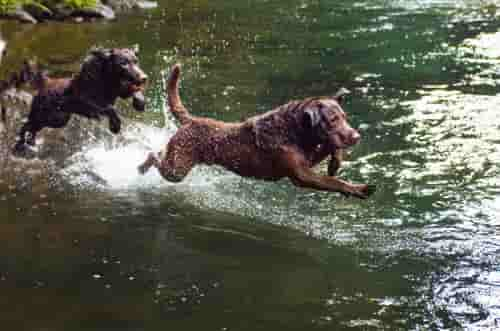 Chessies Doing What They Love!
Chessies Doing What They Love!
Chessies have a dynamic personality. They are an independent and confident breed and will
happily take the dominant role if allowed. They need an owner who is self assured and can provide strong leadership.
Obedience training will
put the owner in control and is best carried out in a firm, consistent, but not unkindly manner. They are very
intelligent dogs that learn quickly and are eager to please their owners.
The Chessie should be well-socialized from an early age to balance out his protective orientation and/or any dog aggressive tendency. Spend some time introducing him to other people and dogs as well as a variety of places and situations.
Appearance of the Chessie
Height: males: 23-26 inches, females: 21-24 inches
Weight: males: 65-80 lbs, females: 55-70 lbs.
Color variations: Various shades of brown or sedge, though the most favored color would be one that blends in with the terrain in which the dog works, which is often described as dead grass or hay.
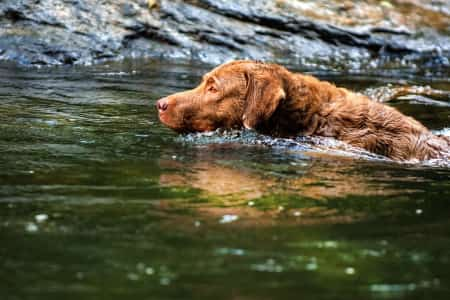
Coat and Care
The outer coat is short, thick, very coarse and partly wavy except on the face and legs, while the undercoat is dense, though quite fine and woolly.
The coat is ideally suited for working in bad weather and cold waters and dries easily with merely a shake.
The Chessie sheds a substantial amount and even more during seasonal sheddings. Regular brushing with a high quality pin brush will maintain the coat and remove loose hair while being easy on your dog.
Bathe occasionally or just when necessary, but use a low-lather shampoo to prevent stripping coat of natural oils which make his coat waterproof and protect him in the cold water.
Inspect the nails routinely for necessary trimming and check the ears often for wax buildup, dirt, or signs of infection. Keep the ears dry after your dog has been in the water or been bathed. Brush teeth daily with a pet toothpaste.
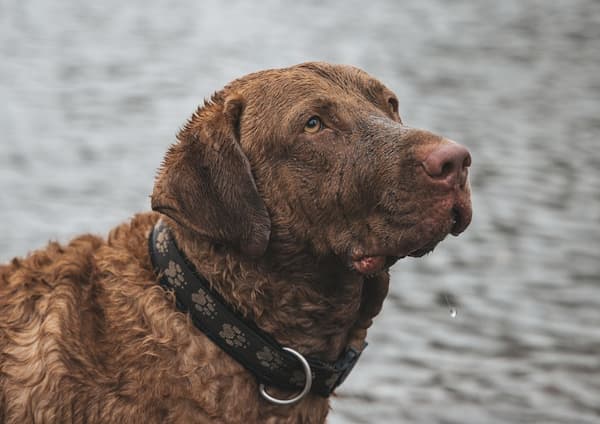
Health
This large and powerful dog has a lifespan of 10 to 12 years.
If the CBR leads the highly active lifestyle he was bred for, he will need a very nutritious diet to live to this potential, plus good veterinary care along the way to monitor his health.
Some of the canine diseases that may affect this breed include:
- Hip dysplasia: This is an inherited issue involving the hip joint that results in pain, muscle loss and lameness. It’s a degenerative disease, but there are many treatments and therapies available. Hip dysplasia can affect any dog, but it’s more common in larger breeds.
- Elbow dysplasia: A common cause of front leg lameness. More specifically, an abnormal development of the elbow joint in young, large, rapidly growing dogs. Signs of elbow dysplasia appear in puppies at 4 to 10 months of age.
- Degenerative myelopathy: A progressive adult-onset neurodegenerative disease that affects the spinal cord, and leads to paralysis. The disease is fatal. A DNA test for use by vets, breeders and pet owners through the OFA (Orthopedic Foundation for Animals – ofa.org) is now available to identify this disease.
- Progressive retinal atrophy: This inherited disorder results in vision loss and eventually blindness with no cure. However, genetic screening testing is available so be sure to ask your breeder.
- Potentially other hereditary eye diseases.
- EIC (Exercise induced collapse): This is an inherited neuromuscular disorder characterized by muscle weakness and lack of coordination during exercise. Signs are stumbling, loss of balance, or complete collapse during, or after, intense activity.
Good breeders will have puppy parents (sire and dam) evaluated for all the tests that are available for these and other conditions, including eyes, before breeding. Buyers should ask to see certificates verifying testing.
Much of the testing can be done by the Orthopedic Foundation for Animals OFA
How Active Are Chesapeake Bay Retrievers?
The CBR is probably the most powerful, intelligent and energetic of the entire retriever family.
While relatively quiet indoors, Chessies have awesome stamina and need plenty of exercise. In addition to a twice daily vigorous walking routine, involvement in some kind of retrieving activity or field trials is a must.
Your Chessie will love the opportunity to swim and retrieve balls or sticks from the water and it is a perfect game for his high energy. Just be prepared to get tired before he does!
Without sufficient physical and mental stimulation, watch out for undesirable behavior!
Ideal Living Conditions
The Chesapeake Bay Retriever is not a suitable breed to house in small quarters such as an apartment or condo.
Ideally, he needs to have access to a significant yard and plenty of room to run. Access to a body of water where dogs are allowed to swim would be the optimum.
Suitable Companion For Children?
Chessies are not the best choice for families with young children. He will do better with mature older children after he has been accustomed him to their behaviors. Likewise, when the children have been taught how to act responsibly around pets, especially large ones.
The best policy in families where children interact with pets, is to always have adult supervision, no matter what the
breed of dog.
Senior or Less Active Families?
While the Chesapeake Bay Retriever is a loyal and protective dog breed, the high exercise requirement, plus the need for very self-assured leadership, would not make this the most suitable breed for the less active lifestyle.
Share Your Knowledge
The Chesapeake Bay Retriever is an uncommon breed so If you're a proud owner or fancier of a Chessie, we'd really like to hear from you.
Please tell us what drew you to the breed, the ins and outs of training and living with your dog on a day to day basis. plus the pros and cons a prospective owner should consider before deciding if it would be a good match for them.
This type of information would be enormously helpful to someone researching the breed for their family.
You can tell your story here.
FAQs
Find a Chesse to Buy or Adopt
Puppies will generally cost between $1,000 and $3,500, but can go much higher depending on several factors such as: reputation of the breeder, the pedigree, show quality, health and genetic testing etc.
Be sure to avoid backyard breeders as many are only interested in making sales and not in prioritizing the health of the litter and placing the pups in the right homes.
Always choose a responsible breeder or rescue organization to ensure your Chesapeake Bay Retriever is healthy and well-socialized.
Book Recommendation
Up-to-date resource covering the breed's characteristics, grooming,
selection, nutrition, healthcare, house training and basic commands. Comprehensive guide
for the novice owner or someone considering the breed.
Written by a respected breeder who provides the pros and cons of Chessies for greater insight into to this workaholic dog!.
Before You Go...
If you like the content of this page, as well as others on my site, please give it some love by clicking on the heart in the lower right hand corner. This helps me keep providing enjoyable and useful content.
Thank you.
- Home ›
- AKC Breeds ›
- Sporting Dog Group ›
- Chesapeake Bay Retriever


